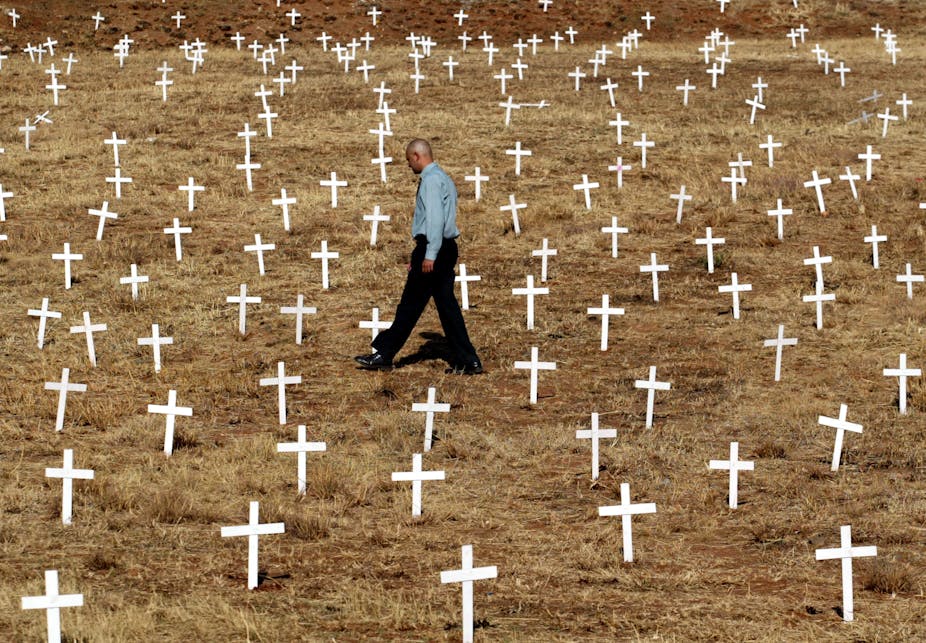Police statistics in South Africa show a worrying trend: the increased use of illegal small arms and light weapons in the country’s growing problem of violent crime.
Gun-related murders are the leading cause of violent death, placing the country second in the world after the US. South Africa’s population is 51,8 million compared to the US’ 321,9 million.
The Geneva Declaration Secretariat says South Africa’s homicide rates are indicative of a warzone or a country in crisis, struggling with stability.
Although South Africa’s homicide rates have declined consistently since democracy, they remain among the highest in the world. They are about four times the global average at more than 30 per 100,000 people.
The South African Police Service stopped publishing disaggregated firearm data in 2000. Different processes are used to collect and monitor data, so firearm statistics have become fragmented and speculative.
A consistent and disturbing trend in post-apartheid South Africa is the rate that state-owned guns land in the hands of criminals through theft, negligence, fraud and corruption. The police’s secretariat recently said that more than 1900 guns belonging to the police, defence force and the prisons went missing over the past year.
Police sting operations frequently uncover and destroy large illegal caches. Several amnesty programmes have been used to reduce the number of illegal firearms in circulation. The 2005 amnesty netted 100,000 guns. But without reliable, transparent crime statistics and ongoing research, measures to eliminate illegal small arms and light weapons will remain largely “hit and miss”. Their proliferation will remain largely misunderstood.
A continental problem
Africa is awash with arms. It has the greatest number of armed conflicts. Numerous intra-state clashes, extremist insurgencies and resource conflicts dominate the post-Cold War geopolitical landscape.
A distinct feature of these “new wars” is the use of fast-paced, mobile, guerrilla warfare tactics. The tools, increasingly hi-tech, are small arms and light weapons – the perfect instruments in this theatre of violence.
The United Nations Institute for Disarmament Research categorises small arms as revolvers, self-loading pistols, rifles, submachine guns and light machine guns. Light weapons are heavy machine guns, hand-held under-barrel and mounted grenade launchers, portable launchers of antitank and antiaircraft missile systems and mortars of less than 100mm calibre.

Small arms and light weapons have distinctive advantages which make them ideally suited to “modern” guerrilla warfare and urban armed crime. They are:
low cost and widely available. They are accessible, cheaply manufactured and easily distributed by illegal trading and trafficking;
increasingly lethal. Non-state actors, informal militias, and extremists have lethal firepower that often exceeds that of state military forces;
simple and durable. They are easy to maintain, can be recycled and can last decades; and
in need of little training. Their utility is unrestrained by gender or age, increasing their use by informal militias and child soldiers.
The AK-47, an iconic struggle weapon of African liberation, lasts 20 to 40 years. It is also the weapon of choice for terrorists and drug lords globally. It is easily transported, smuggled to conflict zones and cached.
The sources of the proliferate weapons in Africa are many and diverse, legal and illegal. Their flow is extremely difficult to track or monitor. One important source is the stockpiles of Cold War weaponry still circulating throughout the continent. Small arms and light weapons are frequently recycled from conflict zone to conflict zone, and among fighters, security forces and war profiteers.
The scourge of the weapons has transformed the landscape of African armed violence. Their accumulation has devastating consequences, with huge humanitarian costs, human rights violations and abuses. They are implicated in the massive flows of refugees and internally displaced people in Africa.
The weapons fuel, aggravate and escalate conflicts. They also spawn a culture of violence and impunity. Their intractability thwarts conflict resolution and peace-building efforts on the continent.
Given the accessibility, low cost and portability of the weapons, the lucrative, illicit arms trade is extremely challenging to governments. Even the most comprehensive, long standing arms embargoes, non-proliferation treaties, and UN protocols have failed to shut down their illicit trade and trafficking.
Structural violence in South Africa
Arms are entrenched in the South African psyche, thanks to a militarised police state under apartheid and a history of protracted armed conflicts. Accumulating small arms and light weapons was rife during apartheid.
With post-Cold War weapons still in circulation and caches of arms of the liberation armies seemingly not accounted for, post-apartheid South Africa was always at risk of continued instability from armed crime.

This has been the post-conflict experience in Africa, where criminal syndicates fill the vacuum caused by the cessation of political hostilities, capitalising on existing arms networks. Porous and extensive borders such as those of South Africa facilitate the illegal trafficking of weapons, other illicit goods and the movements of crime syndicates.
Research confirms that the proliferation of arms and the process of militarisation in regions where structural violence is the norm exacerbate societal dysfunction, political turmoil and erode state authority.
Disconcerting future
Incidents in South Africa reflect the growing militarisation of the police, reminiscent of apartheid policing and armed struggle. This speaks to serious regression in South Africa’s progressive agenda of human rights, dignity and democracy.
The 2012 Marikana massacre epitomises this military-style brutality by police, who killed 34 striking miners. The Human Rights Commission criticised the police for using excessive and lethal force.
Research suggests armed violence, systemic poverty and inequality are linked. Countries with entrenched armed violence, as experienced in South Africa, are in danger of being trapped in cycles of under-development. The proliferation of weapons contributes to disintegrative trends in society, accelerating tensions through criminal activities and civil conflict.
South Africa, which is one of the most unequal societies in the world, with severe levels of structural violence and poverty, is particularly vulnerable to ever widening socioeconomic cleavages. Proliferating illicit weapons pose a real threat to sustainable peace and the fabric of society as they accelerate armed criminal violence.

